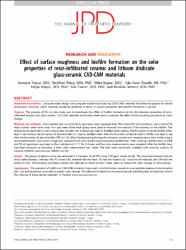Effect of surface roughness and biofilm formation on the color properties of resin-infiltrated ceramic and lithium disilicate glass-ceramic CAD-CAM materials

Göster/
Tarih
2024Yazar
Topçu, SümeyraTekçe, Neslihan
Kopuz, Dilan
Yazıcı Özçelik, Eda
Kolaylı, Fetiye
Tuncer, Safa
Demirci, Mustafa
Üst veri
Tüm öğe kaydını gösterKünye
Topçu, S; Tekçe, N; Kopuz, D; Yazıcı Özçelik, E; Kolaylı, F; Tuncer, S; Demirci, M. Effect of surface roughness and biofilm formation on the color properties of resin-infiltrated ceramic and lithium disilicate glass-ceramic CAD-CAM materials (2024). Journal of Prosthetic Dentistry.Özet
Statement of problem: Computer-aided design and computer-aided manufacturing (CAD-CAM) materials have become popular for dental restorations; however, which materials should be preferred in terms of surface properties after biofilm formation is unclear. Purpose: The purpose of this in vitro study was to investigate the effect of biofilm formation on the discoloration properties of resin-infiltrated ceramic and glass ceramic CAD-CAM materials and human teeth and to examine the effect of the brushing procedure on color change. Material and methods: One hundred and six 2-mm-thick specimens were prepared from IPS e.max CAD and Cerasmart, and a total of 53 intact human teeth were used. Five specimens from each group were used to measure the amount of live biomass in the biofilm. The remaining 48 specimens in each group were divided into 4 subgroups: kept in distilled water without the formation of dental biofilm (DW), kept in tea without the formation of dental biofilm (T), kept in distilled water after the formation of dental biofilm (DWB), and kept in tea after the formation of dental biofilm (TB) (n=12). After finishing and polishing the materials, initial color measurements were made using a spectrophotometer, and surface roughness measurements were made using noncontact profilometer. After creating a biofilm layer in DWB and TB, all specimens were kept in their solutions at 37 °C for 24 hours, and the color measurements were repeated. After the biofilm layer had been removed by brushing, a third color measurement was made. The data were statistically analyzed with one-way analysis of variance (ANOVA) and two-way ANOVA (α=.05). Results: The lowest roughness value was observed in Cerasmart. Tooth-IPS e.max CAD gave similar results. The Cerasmart material had the most viable biomass, whereas the IPS e.max CAD material had the least. TB had the highest ΔE1 value for all materials and DW had the lowest (P<.05). The brushing procedure caused the materials to return to their initial colors or reduce the color change in most groups. Conclusions: The presence of biofilm on CAD-CAM materials immersed in distilled water caused an unacceptable degree of discoloration (ΔE>1.8), and immersion in tea led to greater color change. The adhesion of biofilm to restorative dental materials plays an important role in the coloring of these dental materials.
Kaynak
Journal of Prosthetic DentistryBağlantı
https://www.sciencedirect.com/science/article/pii/S0022391324001197?pes=vorhttps://doi.org/10.1016/j.prosdent.2024.02.005
https://hdl.handle.net/20.500.12780/781

















